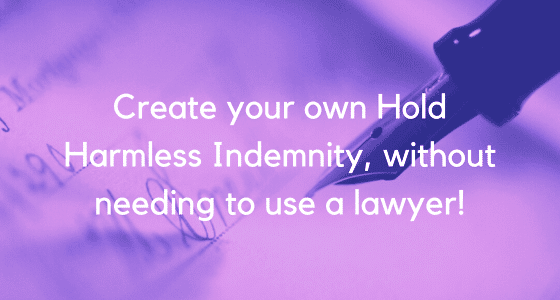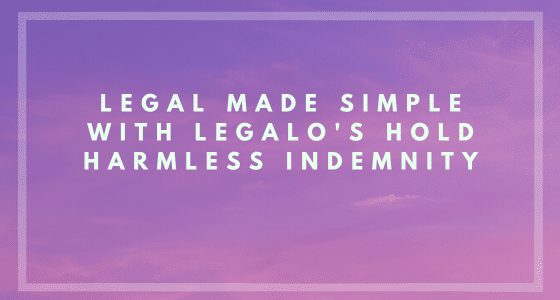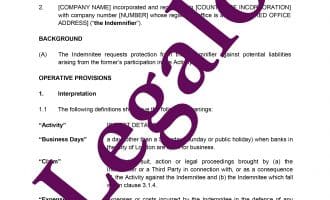Hold Harmless Indemnity
Our Hold Harmless Indemnity template:
- easy to use and reliable agreement
- expertly-drafted template
- guidance notes in plain English
- cost-effective peace of mind

How Does It Work?
-
1. Download
-
2. Edit
-
3. Print
-
4. Sign
Our Hold Harmless Indemnity agreement template is for use by someone who has agreed with another that one of them will indemnify the other for problems arising out of the proper fulfilment of a contract between them. This Hold Harmless agreement is supplemental to such other contract – this will frequently be a contract for the sale of goods (or the supply of services) on the standard business terms of the supplier.
You can insert the contents of the agreement into a letter, but we recommend putting it in place as a separate formal contract.

About our Hold Harmless Indemnity Template
Hold harmless indemnities are often known by various different names, such as:
1. a hold harmless agreement; or
2. an indemnity.
UK suppliers of goods often use such an indemnity, for example, where they are supplying goods to merchants in USA for distribution in USA. The UK supplier does not want to bear the risk of legal claims against it from end users in USA, with the associated risks of huge compensation demands and large legal fees.
It may also be that the supplier, who is based outside the US, has been required to obtain such an indemnity by their non-US insurance company as a requirement in order for their insurance to include sales to the US.
Our template Hold Harmless Indemnity is suitable for use in all such situations. It takes very little time to complete, so you will find it quick and easy to use.
David, our co-founder and solicitor of over twenty years, has drafted this template. This ensures that you can rely on the document being up-to-date and legally comprehensive. Our detailed guidance notes (included free with the template) offer a clause-by-clause explanation of the agreement. A copy of the guidance notes are also available here: guide to this template.
Using Our Hold Harmless Indemnity Template
You can download this draft for a hold harmless indemnity in Word format at the click of a button. You can then easily edit it to suit your own needs.
We provide a full money-back guarantee if you are not happy with your template document for any reason. So you can buy with peace of mind.
You can reuse this hold harmless template as many times as you want. So you can create more such indemnities at no further cost. We keep our templates under review to ensure they are up to date. When we update a template that you have bought, we will notify you by email. Then you will get a free access to the updated template.
Other Commercial Templates Available
If you would like to see the full range of our commercial agreement templates, click the link.

FAQs on the Hold Harmless Indemnity
Below, we have answered the most popular questions from the Internet on this topic.
What does a hold harmless agreement mean?
There are two ways of looking at this. When used correctly, a hold harmless agreement, or indemnity agreement, is a legal contract that releases one party from potential liability for specific claims or losses. It transfers responsibility from one party to another, usually in situations involving risk or potential legal disputes. The party providing the indemnity agrees to bear the costs or damages that would otherwise be incurred by the party being held harmless. These agreements are frequently used in contracts like leases, construction projects, and distribution / reseller agreements to outline the distribution of legal and financial obligations between the involved parties.
As an example, this might be used if a manufacturer is selling goods to a reseller or distributor in USA, where it is considered a highly litigious country and therefore one where strange and unusual liabilities would be deemed the responsibility of the manufacturer if inadequate warning messages did not come with the goods. So in this case the manufacturer would request a hold harmless agreement from the reseller or distributor. This would then prevent the manufacturer being troubled by nonsensical claims brought in that other country. Also the reseller is better placed to take out its own product liability insurance in that country.
When would you not want to use one?
When used more dangerously, the hold harmless indemnity increases the potential liability of a party, such as a seller. So for example, a manufacturer is already responsible for the safety of its product and sells it to a reseller, offering a normal 1-year warranty to end users, but the reseller demands a hold harmless indemnity from the manufacturer in addition. This raises the exposure of the manufacturer. For example, if the reseller is sued by an end user, the reseller can defend the claim in court and claim all the legal defence costs from the manufacturer, without the manufacturer being involved in the defence or the choice of lawyer. You can see this use of the hold harmless indemnity could be very dangerous to the manufacturer. We recommend the hold harmless indemnity is not given in such a situation.
Another example of using the indemnity in this way would be the main contractor in a building project who asks all its subcontractors on the project to give it a hold harmless indemnity. This is fairly common and hopefully the subcontractor has appropriate insurance.
What is the difference between release and hold harmless?
A “release” and a “hold harmless” agreement have opposite functions. A release is a legal document that waives one party’s right to pursue legal claims against another, effectively absolving any claims or liabilities associated with a particular situation. Conversely, a “hold harmless” agreement, also known as an indemnity agreement, does not waive claims but rather establishes that one party will be protected from liabilities or claims by the other. In essence, a release terminates legal claims, while a “hold harmless” agreement sets out specific responsibility for potential claims.
However, you can use a hold harmless indemnity in a way that it is effectively a release of liability of someone who might normally bear that liability. This is the example we have given of the reseller releasing the manufacturer under the first question above, due to the reseller giving the manufacturer the hold harmless indemnity.
What is the difference between a hold harmless letter and a letter of indemnity?
A hold harmless letter and a letter of indemnity share the common goal of providing legal protection, with one party providing the indemnity in question to the other. So essentially they are the same type of document.
What is another name for a hold harmless agreement?
A hold harmless agreement is also referred to as an “indemnity agreement” and these terms are commonly used interchangeably in legal settings. Both types of agreements establish the division of legal responsibilities and protections between parties, clearly defining who will assume the financial and legal liabilities in specific circumstances.
What are the three 3 methods of indemnity?
There are three primary methods of indemnity: contractual indemnity, equitable indemnity, and statutory indemnity. We explain each briefly below:
- Contractual Indemnity: This method is the most common and involves outlining indemnification terms in a contract, specifying which party will be responsible for losses or liabilities in specific situations. So this is where you might use a hold harmless indemnity.
- Equitable Indemnity: This is a legal remedy where one party seeks indemnification from another based on fairness or equitable principles, often in cases involving multiple parties at fault. It means one party taking the other to court to claim such an indemnity. It is up to the court to provide it if it agrees with the claim. The parties might settle such a dispute before the court hearing by using a hold harmless indemnity.
- Statutory Indemnity: Some laws and regulations establish indemnification obligations, such as environmental regulations that require parties responsible for contamination to indemnify affected parties.
What are the three types of hold harmless?
There are three prevalent types of “hold harmless” agreements:
- Broad Form: This type indemnifies one party from all liabilities, including losses caused by their own negligence or caused by third parties. Sometimes the use of this type is abusive, coercive or forced on the other party due to the first’s stronger bargaining position. As a result, the courts sometimes rule that this type is unenforceable.
- Intermediate Form: It protects one party for all of the negligence or wrongdoing of the other, excluding the first party’s negligence.
- Limited Form: This type holds one party harmless for specific claims or liabilities specified in the agreement due to the other party’s negligence, typically excluding the first party’s gross negligence or intentional misconduct. So a sub-contractor might indemnify a main contractor in a building project proportionally for losses caused by its sole negligence.
For more explanation on these three types see: https://www.msonet.com/msosite/wp-content/uploads/2019/01/An-Intro-to-Hold-Harmless-and-Indemnity-Agreements.pdf. The selection of the appropriate type depends on the particular circumstances and the intentions of the parties involved in the agreement.
What does it mean to indemnify someone?
To indemnify someone is to offer legal or financial security against potential losses, damages, claims, or liabilities. The indemnifying party commits to bearing the costs or consequences of specific events, detailed in a contract. This arrangement protects the indemnified party from costs or losses associated with the agreed-upon circumstances. This is because the indemnifying party assumes responsibility for those risks.
Why would you need a hold harmless agreement?
A hold harmless agreement is essential for establishing legal responsibilities between parties in various scenarios, including contracts and other activities. It serves multiple purposes:
- Risk Management: By designating which party will assume specific claims or losses, it aids in the management of potential risk.
- Legal Clarity: It provides explicit terms and conditions for indemnification, reducing the likelihood of disputes and legal conflicts.
- Contractual Requirement: Certain contracts or legal regulations may necessitate hold harmless agreements to safeguard the parties involved.
- Business Agreements: Parties in business, construction and real estate commonly use hold harmless agreements to define responsibilities concerning legal matters.
Without a full indemnity, a couple of factors limit the usual contractual level of liability:
- to the “reasonable” legal costs (often only around 70% of those really incurred) – not the full actual legal costs incurred;
- by the other party being under a duty to mitigate or reduce their losses where reasonably possible; and
- the onus is on the claimant to prove their loss and that the other party caused it.
What is an example of a hold harmless agreement?
In a construction contract, the main contractor would be vicariously liable for the subcontractor’s work. So a subcontractor might hold harmless the main contractor from any claims or costs from their work. By doing so, the subcontractor takes on the responsibility for any injuries, property damage, or legal claims stemming from their actions, safeguarding the main contractor from potential legal and financial repercussions.
What should be included in a hold harmless agreement? How do you write a simple hold harmless agreement?
A comprehensive hold harmless agreement should encompass the following essential components:
- Party Identification: Clearly identify the parties involved: the beneficiary of protection and the indemnifying party.
- Protection Scope: Define the extent of coverage, outlining the specific claims or liabilities that the indemnity covers.
- Indemnification Terms: Elaborate on the circumstances that trigger indemnification and outline the responsibilities of each party.
- Insurance Requirements: Specify any insurance obligations and the associated coverage.
- Jurisdiction and Law: Specify the court jurisdiction to use for any disputes, and the law that applies to the agreement.
- Signatures and Dates: Ensure that all parties sign the agreement, and include the effective date.
What is a hold harmless against the seller?
This is a contractual provision that safeguards the buyer from specific claims or liabilities associated with a purchase. This provision states that the seller will assume responsibility for any legal or financial repercussions arising from:
- defects the seller has not disclosed (or perhaps not known about);
- breaches of the agreement; or
- liabilities related to the property or goods it is selling.
So by incorporating this provision, the buyer has extra protection from pre-existing or undisclosed issues.



